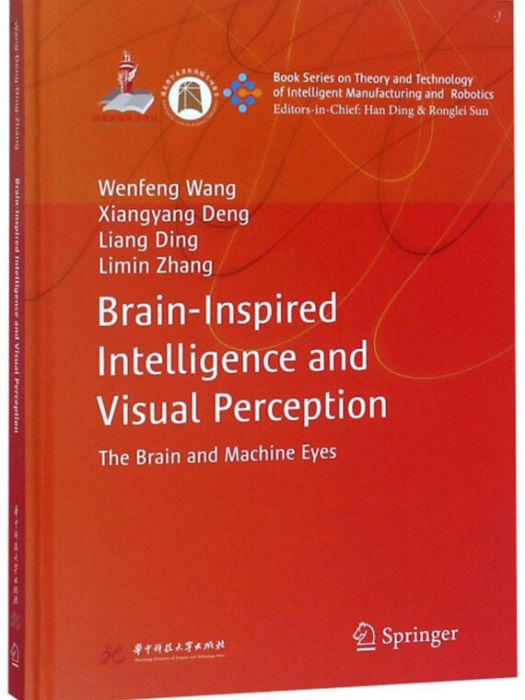《Brain-inspired Intelligenceand Visual Perception:The Brain and Machine Eyes》是2019年3月1日華中科技大學出版社出版的圖書,作者是Wenfeng、Wang、Xiangyang、Deng、Liang。
基本介紹
- 中文名:Brain-inspired Intelligenceand Visual Perception:The Brain and Machine Eyes
- 作者:Wenfeng、Wang、Xiangyang、Deng、Liang
- 出版社:華中科技大學出版社
- ISBN:9787568050791
內容簡介,圖書目錄,
內容簡介
《類腦智慧型與視覺感知(英文版)》主要介紹關於大腦啟發的智力和視覺感知(BIVP)研究的新成果。
《類腦智慧型與視覺感知(英文版)》著者們收集BIVP的新的研究假設,包括介紹腦科學和視覺腦假說。此外,本文還介紹了BIVP的理論和算法,包括信息素積累與疊代、神經認知計算機制、核心模組的集成與調度、大腦感知、運動與控制。
《類腦智慧型與視覺感知(英文版)》不僅包含基本概念、理論和規律,以前分散在許多有影響的期刊和會議上,而且包含作者的項目中的一系列新研究進展,包括中國科學院的“西部之光”計畫(XBBS-2014-16),國家自然科學院中國科學基金會(41571299)、中國“千*計畫”(Y47161)、國家基礎研究計畫(2013CB035502)和國家高技術研究發展計畫(2013AA122302)。
《類腦智慧型與視覺感知(英文版)》即可以供大學研究人員、研發工程師、本科生和研究生學習以及對機器人、腦認知或計算機視覺感興趣的讀者參考。
圖書目錄
1 Introduction of Brain Cognition
1.1 Background
1.2 Theory and Mechanisms
1.2.1 Brain Mechanisms to Determine Attention Value of Information in the Video
1.2.2 Swarm Intelligence to Implement the Above Biological Mechanisms
1.2.3 Models Framework for Social Computing in Object Detection
1.2.4 Swarm Optimization and Classification of the Target Impulse Responses
1.2.5 Performance of Integration Models on a Series of Challenging Real Data
1.3 From Detection to Tracking
1.3.1 Brain Mechanisms for Select Important Objects to Track
1.3.2 Mechanisms for Motion Tracking by Brain-Inspired Robots
1.3.3 Sketch of Algorithms to Implement Biological Mechanisms in the Model
1.3.4 Model Framework of the Brain-Inspired Compressive Tracking and Future Applications
1.4 Objectives and Contributions
1.5 Outline of the Book
References
2 The Vision-Brain Hypothesis
2.1 Background
2.2 Attention Mechanisms
2.2.1 Attention Mechanisms in Manned Driving
2.2.2 Attention Mechanisms in Unmanned Driving
2.2.3 Implications to the Accuracy of Cognition
2.2.4 Implications to the Speed of Response
2.2.5 Future Treatment of Regulated Attention
2.3 Locally Compressive Cognition
2.3.1 Construction of a Compressive Attention
2.3.2 Locating Centroid of a Region of Interest
2.3.3 Parameters and Classifiers of the Cognitive System
2.3.4 Treating Noise Data in the Cognition Process
2.4 An Example of the Vision-Brain
2.4.1 Illustration of the Cognitive System
2.4.2 Definition of a Vision-Brain
2.4.3 Implementation of the Vision-Brain
References
3 Pheromone Accumulation and Iteration
3.1 Background
3.2 Improving the Classical Ant Colony Optimization
3.2.1 Model of Ants' Moving Environment
3.2.2 Ant Colony System: A Classical Model
3.2.3 The Pheromone Modification Strategy
3.2.4 Adaptive Adjustment of Involved Sub-paths
3.3 Experiment Tests of the SPB-ACO
3.3.1 Test of SPB Rule
3.3.2 Test of Comparing the SPB-ACO with ACS
3.4 ACO Algorithm with Pheromone Marks
3.4.1 The Discussed Background Problem
3.4.2 The Basic Model of PM-ACO
3.4.3 The Improvement of PM-ACO
3.5 Two Coefficients of Ant Colony's Evolutionary Phases
3.5.1 Colony Diversity Coefficient
3.5.2 Elitist Individual Persistence Coefficient
3.6 Experimental Tests of PM-ACO
3.6.1 Tests in Problems Which Have Different Nodes
3.6.2 Relationship Between CDC and EIPC
3.6.3 Tests About the Best-Ranked Nodes
3.7 Further Applications of the Vision-Brain Hypothesis
3.7.1 Scene Understanding and Partition
3.7.2 Efficiency of the Vision-Brain in Face Recognition
References
4 Neural Cognitive Computing Mechanisms
4.1 Background
4.2 The Full State Constrained Wheeled Mobile Robotic System
4.2.1 System Description
4.2.2 Useful Technical Lemmas and Assumptions
4.2.3 NN Approximation
4.3 The Controller Design and Theoretical Analyses
4.3.1 Controller Design
4.3.2 Theoretic Analyses of the System Stability
4.4 Validation of the Nonlinear WMR System
4.4.1 Modeling Description of the Nonlinear WMR System
4.4.2 Evaluating Performance of the Nonlinear WMR System
4.5 System Improvement by Reinforced Learning
4.5.1 Scheme to Enhance the Wheeled Mobile Robotic System
4.5.2 Strategic Utility Function and Critic NN Design
4.6 Stability Analysis of the Enhanced WMR System
4.6.1 Action NN Design Under the Adaptive Law
4.6.2 Boundedness Approach and the Tracking Errors Convergence
4.6.3 Simulation and Discussion of the WMR System
References
5 Integration and Scheduling of Core Modules
5.1 Background
5.2 Theoretical Analyses
5.2.1 Preliminary Formulation
5.2.2 Three-Layer Architecture
5.3 Simulation and Discussion

